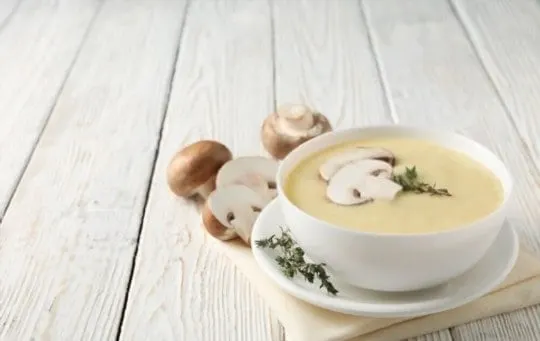Soup is the most comforting and warming of all foods.
But it only takes a few minutes to make and is infinitely variable, depending on what you’ve got in the cupboard, fridge, and freezer.
The most popular soups, by far, are thick and creamy—the Cream of Mushroom, Chicken Noodle, Mulligatawny with coconut milk, etc.
The list is endless. These days cream soup recipes require ‘light’ or semi-skimmed margarine or other spread instead of butter.
It’s a good move because it reduces saturated fats in our diet.
There’s no need to worry about the soup being fatty; cream and milk bring a soothing creaminess to any soup.
The trick is to add them at the right time in the cooking process.
Cooking times vary due to different brands of stock cubes or powder, but these usually range from 10-25 minutes; vegetables take slightly longer but are also usually added simultaneously.
You can make cream soups in advance, refrigerate them and then heat through when you’re ready to eat – they’ll keep for days.
If you want to extend the life of your soup still further, try freezing it.
Freezing soup is a good idea because it extends its life.
It also avoids the need to have several cans of soup in your cupboards, which wouldn’t be very economical.
In this article, we will guide you step-by-step through the freezing of Cream Soups.
Does Freezing Affect Cream Soups?

Cream soups tend to separate when they are frozen.
They may also thicken and require defrosting before eating – this is especially true if you freeze the soup immediately after it’s cooked.
However, as long as your glass jars are airtight, freezing shouldn’t affect the quality or taste of your soups.
What happens when you freeze soup? Well, freezing causes water molecules to form very small ice crystals, which rupture cell walls in vegetables.
The disruption of cell structure means that some flavor and color can be lost; however, this doesn’t happen with cream soups because they already have a stabilizing agent of some sort added – either flour or corn starch.
Freezing doesn’t affect all vegetables in the same way.
Carrots, for example, freeze better than peas and are less prone to become watery or mushy when thawed out.
Similarly, freezing doesn’t seem to harm creamy soups like potato or leek, which contain many starches, but care should be taken with cream of celery soup with virtually no starch.
Cream soups are also more susceptible to freezing than any other soup because the milk or cream tends to float on top of the mix as it freezes and causes a layer of thin ice crystals which separate it from the remainder.
This means that if not thawed correctly, your soup can taste watered down by defrosting.
The best way to overcome this is to stir the cream or milk through the soup before freezing.
Alternatively, you could add another ingredient, such as corn starch which will thicken the mixture and prevent a layer from forming on top.
How to Freeze Cream Soups?

Freezing cream soups can be easily done with a little forethought and preparation.
Like most foods, preparation is the key to a successful freezing process.
Always let the soup cool before you freeze it.
Make sure they are always covered – this will prevent moisture from escaping and help avoid any freezer burn.
The best way to freeze soup ahead is in ice cube trays and then transfer into freezer bags or containers, where you can portion out individual servings.
Another good method is to freeze cream soups in airtight containers.
This is also a good method for freezing stocks and adding to soups later.
If you are using glass jars, just remember to leave enough room at the top, so the soup doesn’t overflow when it freezes.
Plastic containers should be filled no more than three-quarters full because they expand as they freeze.
If your soup contains meat or pasta, it’s best to freeze them separately and add them later as they tend to go soggy if frozen with the rest of the soup.
When you’re ready to serve your cream soups, make sure that all parts are at room temperature so that nothing is too cold.
If you eat directly from the freezer, some of the creamy parts may be frozen, and you won’t get the full benefit.
Before serving, make sure that no ice remains in your soup.
If you’re adding cream to thaw out your soup, always stir from the bottom rather than shaking.
If you need to add water, this can wait until after the process finishes; otherwise, this will dilute your soup and change the consistency.
Don’t forget that soup freezes better when you leave some room at the top of the container – air expands when it is frozen, so this will allow for expansion without overflowing.
How to Thaw and Reheat Frozen Cream Soups?

If you find yourself with a frozen cream soup and don’t have time to thaw it, you can do so in three ways:
- Overnight in the refrigerator.
- In a pan over low heat, constantly stirring (Do this very slowly and carefully as a hot soup can scald your skin or cause burns.).
- Applying direct heat to the container with a microwave or oven (This is not recommended because it tends to separate the cream from the soup).
If you are defrosting a soup in the refrigerator, make sure that it is covered so that bacteria doesn’t form.
Frozen cream soups can be frozen for up to three months if they have been well prepared.
If your soup tastes watery or has lost its flavor, this will indicate poor freezing methods and a great loss of nutrients and flavor.
Once thawing has been completed, add any meat to the soup and proceed with reheating.
Allow it to simmer for about five minutes before serving. Follow these steps, and freezing cream soups will be a breeze.
You can always go out of your way to prepare soups in advance and have them at hand when you need them most.
How to Tell if Frozen Cream Soups are Bad?

If you can recall the freezing method and it was done correctly, your soup can be kept frozen for at least three months.
If the outside of the package is dented or crushed, this could indicate a problem.
A freezer burn occurs when ice crystals form on the surface of the food while in the freezer and expel liquid as they do so.
This leaves an undesirable white frost on the food.
No worries, this can be easily removed by scraping off the crystals before reheating and serving.
If your cream soups are bad, they will likely look deflated and will have an unpleasant odor.
If you are uncertain after looking at them, use your nose.
If you are unsure whether your frozen cream soup is safe to eat, throw it out and start over.
If you don’t know if something is bad, play it safe and toss it.
Conclusion
In conclusion, cream soups are a great way to add variety and taste to your food.
They are also very nutritious, so keep them on hand for those days when you don’t feel like cooking or are sick as they are easy to prepare and will make you feel better in an instant.
When you’re freezing your cream soups, keep in mind that it is best to put them straight into the freezer – do not leave them out for too long as this can affect their quality.
Packaging and labeling will also help them last longer.
Follow the steps above to freeze your cream soups safely, and once thawed, heat through before eating.
If it has a change in texture, odor, or consistency, throw it away, as this is a sign that it is no longer safe to eat.

Can You Freeze Cream Soups? Easy Guide to Freeze Cream Soups
Ingredients
- Cream soups
- Air-tight containers or Ziplock bags
- Labels and markers
Instructions
- Prepare all the mentioned equipment and ingredients in the article.
- Follow the steps for proper freezing.
- Label the container with the date and contents.
- Depending on the recipe, thawing time may vary.
